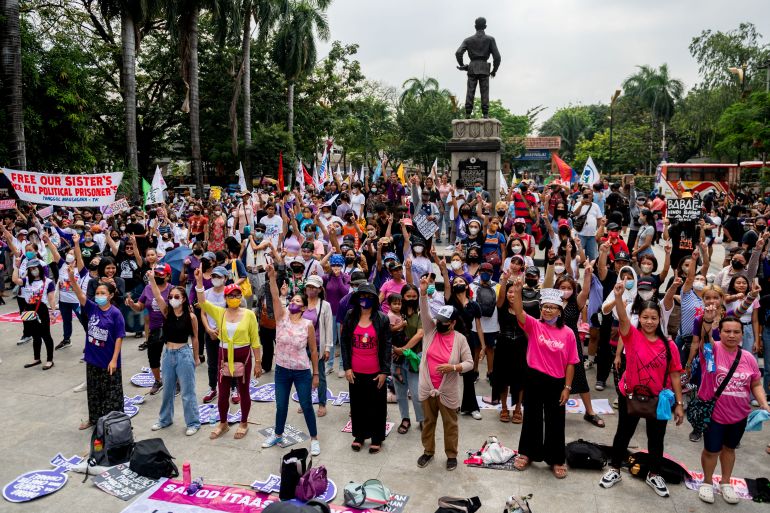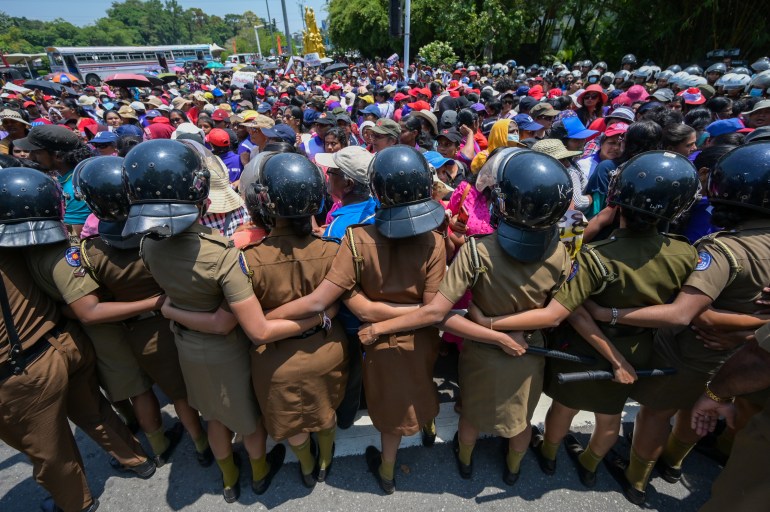What’s International Women’s Day and why is it important?
As the world marks International Women’s Day on March 8, we take a look at the celebration, the theme and its origins.

March 8 is International Women’s Day.
Women across the world use this day to come together to celebrate and rally for equal treatment and representation.
Keep reading
list of 3 itemsWhy are women’s voices marginalised in Nigeria?
Women rally in Pakistan despite attempts to shut down protest
Here is what we know about this year’s celebration:
What’s the theme for International Women’s Day 2023?
The UN’s theme this year is “DigitALL: Innovation and technology for gender equality”.
The topic highlights not only how technology is crucial to advancing rights, but a growing digital gender gap that is impacting everything from job opportunities for women and their safety online.
According to the UN, 259 million fewer women have access to the internet than men, and women are largely underrepresented in science, technology, engineering and mathematics professions.
“Bringing women into technology results in more creative solutions and has greater potential for innovations that meet women’s needs and promote gender equality,” says the UN. “Their lack of inclusion, by contrast, comes with massive costs.”
Previous UN themes have included climate change, rural women and HIV/AIDS.
💙We will not stay silent.
🙌We will not stay still.
🔊We will raise our voices.
✊We will show our will.
⚡️We will #PowerOn until
✔️There is an equitable digital future for all girls and women.Are you with us?#IWD2023 pic.twitter.com/DywzqfziY9
— UN Women (@UN_Women) March 8, 2023
How did the International Women’s Day celebrations start?
The predecessor of International Women’s Day, previously known as National Women’s Day, was first observed in the United States on February 28, 1909, at the suggestion of activist Theresa Malkiel.
The idea of an international women’s day was suggested in 1910 during an International Socialist Women’s Conference in Copenhagen, Denmark.
It was during this conference that Clara Zetkin, a German communist activist, universal suffragist and advocate of women’s rights, proposed the idea that there be a designated day for women everywhere to “press for their demands”. Her idea was met with unanimous approval from all the women present, representing 17 countries.
International Women’s Day was first celebrated in Austria, Denmark, Germany and Switzerland on March 19, 1911, following the agreement at the Copenhagen conference.
Russia celebrated its first International Women’s Day two years later on the last Sunday of February – February 23, 1913.
Why is International Women’s Day important?
While the UN’s theme this year underscores how the fight for gender equality has evolved in the 21st century, celebrations around the world are also focused on longstanding issues, including poverty and violence.
A 2021 World Health Organization report found that nearly one in three women worldwide is subjected to physical or sexual violence during her lifetime, an issue that ties in with women’s economic opportunities, access to sex education and reproductive rights.
The date is an opportunity to raise awareness of rights gaps, and organisers also use the day to celebrate progress and the achievements of individual women.
Tara Cookson, Canada research chair in gender, development and global public policy at the University of British Columbia School of Public Policy and Global Affairs, said this date works as an “advocate tool”.
“It’s one of the ways in which people sort of generate momentum,” Cookson told Al Jazeera.
“It gives us a moment to stop and reflect and learn something new, and maybe carve out 15 minutes, or half an hour, to take some action,” she added.
Cookson also highlighted the relevance of making the date “political”.
“This can be done by supporting an organisation or a member of government who is fighting for some element of women’s human rights, whether that is to institute affordable quality childcare or elder care, or it could be another issue that’s important to you or important to your community,” she added.
How are women marking this date?
Cities across the world are hosting marches, rallies and demonstrations, including Madrid, where broad tree-lined boulevards are regularly packed with a sea of purple, a colour often associated with women’s rights.
In Thailand and Indonesia, a few dozen women gathered in front of the country’s parliament to urge lawmakers to pass a long-awaited bill to protect domestic workers. Some chanted “long live Indonesian women”.
In Sri Lanka, women also protested against the country’s economic crisis.
There are many reasons to protest: In Afghanistan, the Taliban has banned women from attending universities, Iran has repressed protests against the death of Mahsa Amini, new US restrictions on abortion rights and the Ukraine war’s impact on women.
Global progress on women’s rights is “vanishing before our eyes”, according to UN chief Antonio Guterres who said gender equality would take another three centuries to achieve.
“Women’s rights are being abused, threatened, and violated around the world,” he added, pointing to Afghanistan, where “women and girls have been erased from public life”.
